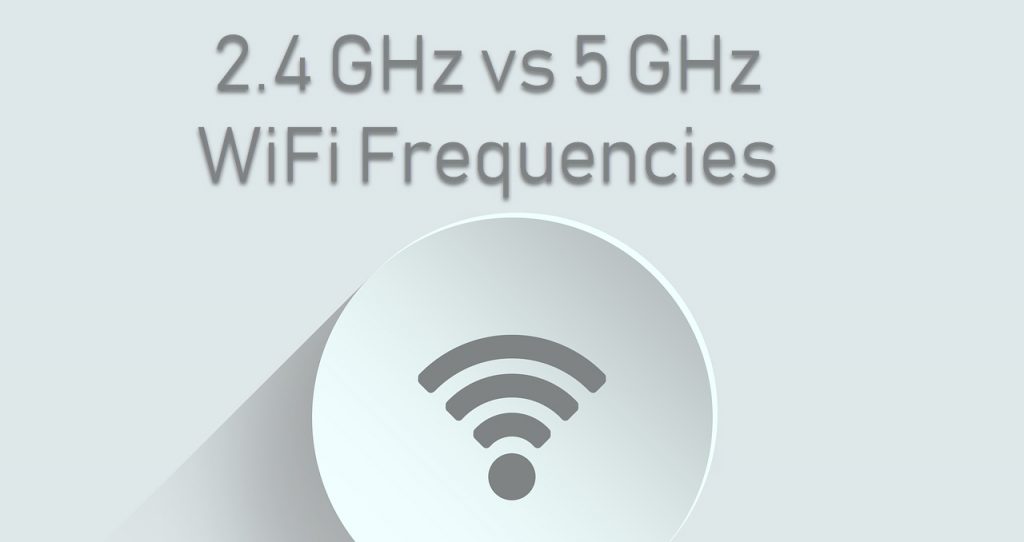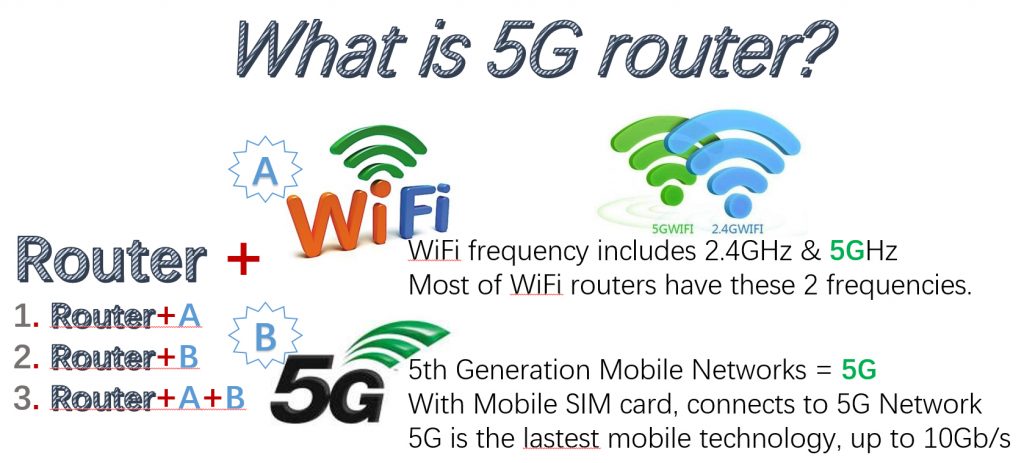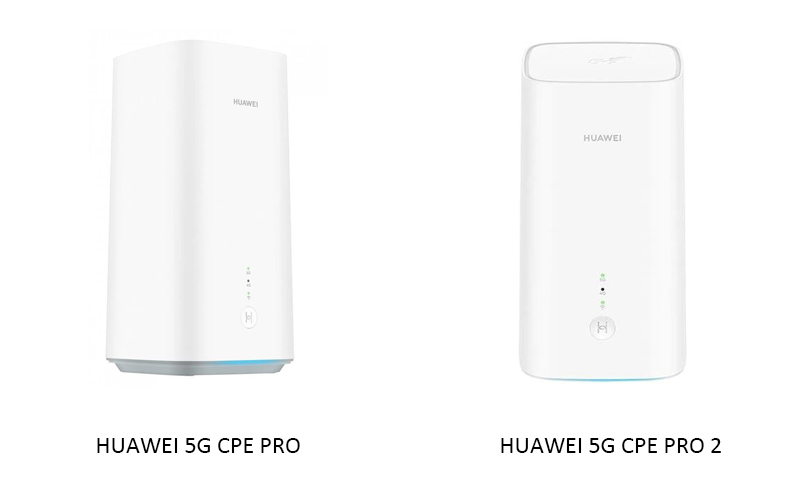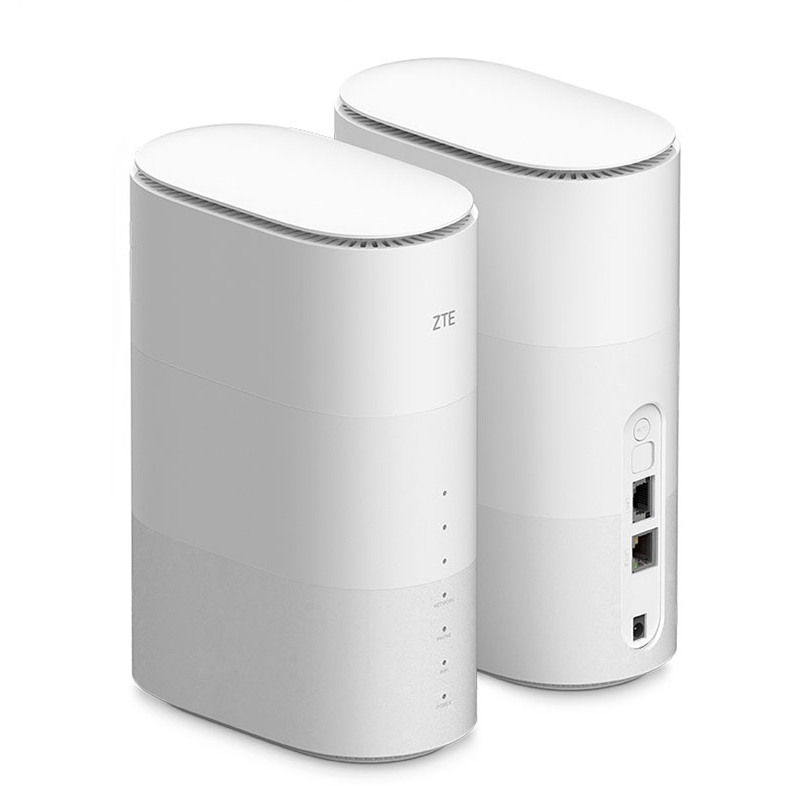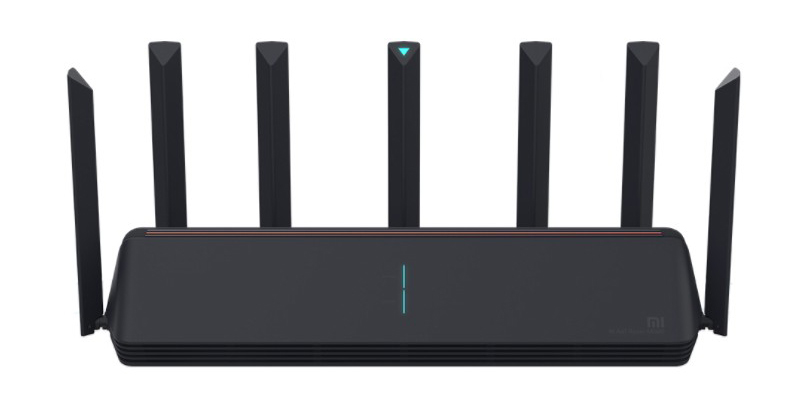
In recent years, many manufacturers have launched 5G routers. Many people have heard of or are using 5G routers, but do you really know what a 5G router is? Before answering this question, we need to solve another question:
- What is 5G?
What is 5G? In fact, the concept of 5G has two kinds of concepts.
(1).WiFi frequency, WiFi frequencies include 2.4GHz and 5GHz
The primary differences between the 2.4GHz and 5GHz signals are speed and range. A 2.4GHz WiFi signal provides internet to a larger area but sacrifices speed, while the 5GHz band provides faster speeds to a smaller area. Below is a list of the different WiFi standards, frequencies, and theoretical distances and speeds.
Table 1. Range comparison – 2.4GHz vs. 5GHz
| Standard | Frequency | Theoretical Distance | Real World Distance |
| 802.11a | 5Ghz | 390 ft | 195 ft |
| 802.11b | 2.4Ghz | 460 ft | 230 ft |
| 802.11g | 2.4Ghz | 125 ft | 62 ft |
| 802.11n | 2.4Ghz | 820 ft | 410 ft |
| 802.11n | 5Ghz | 460 ft | 230 ft |
| 802.11ac | 5Ghz | up to 820 ft (amplified) | up to 410 ft (amplified) |
Table 2. Speed comparison – 2.4GHz vs. 5Ghz
| Standard | Frequency | Theoretical Speed | Real-World Speed |
| 802.11a | 5Ghz | 6-54 Mbps | 3 – 32 Mbps |
| 802.11b | 2.4Ghz | 11 Mbps | 2-3 Mbps |
| 802.11g | 2.4Ghz | 54 Mbps | 10 -29 Mbps |
| 802.11n | 2.4Ghz | 300 Mpbs | 150 Mbps |
| 802.11n | 5Ghz | 900 Mbps | 450Mbps |
| 802.11ac | 5Ghz | 433 Mbps – 1.7 Gbps | 210 Mbps – 1 G |
From these tables we know:
The 2.4 GHz has a farther range than the 5 GHz: in most cases, the higher the frequency of a wireless signal, the shorter its range. The biggest reason for this is that higher frequency signals cannot penetrate solid objects like walls and floors as well as lower frequency signals.
The 5GHz provide much faster data connections than 2.4 GHz: higher bandwidth means that files will download and upload faster, and high-bandwidth applications such as streaming video will perform much smoother and faster. Higher frequencies allow faster transmission of data, also known as bandwidth. Therefore, the 5GHz with its higher bandwidth will provide much faster data connections than 2.4 GHz.
(2).The cellular network concept of mobile communication technology, which represents the 5th generation mobile networks or 5G for short. And 5G would replace 4G LTE mainly due to the prominence that the internet of things technology is going to get in the near future.
The development of mobile networks:
1G (14.4 Kbps ) (1970-1980): During 1G Wireless phones are used for voice only.
2G (9.6/14.4 Kbps) (1990 to 2000): 2G capabilities are achieved by allowing multiple users on a single channel via multiplexing.During 2G Cellular phones are used for data also along with voice.
2.5G (20-40 Kbps) (2001-2004): In 2.5G the internet becomes popular and data becomes more relevant. 2.5G Multimedia services and streaming starts to show growth.Phones start supporting web browsing though limited and very few phones have that.
3G (500-700 Kbps) (2004-2005): 3G has Multimedia services support along with streaming are more popular. In 3G, Universal access and portability across different device types are made possible. (Telephones, PDA’s, etc.)
4G (100-300 Mbps) (Present): Speeds for 4G are further increased to keep up with data access demand used by various services.High definition streaming is now supported in 4G. New phones with HD capabilities surface. Portability is increased further. World-wide roaming is not a distant dream.
5G (Probably Gigabits) (Probably 2020):Currently there is no 5G technology deployed but under testing. Users will know it as one of the fastest, mostrobust technologies the world has ever seen.
That means quicker downloads, much lower lag and a significant impact on how we live, work and play. The connectivity benefits of 5G are expected to make businesses more efficient and give consumers access to more information faster than ever before. Connected cars, smart communities, industrial IoT, immersive education—they all will rely on 5G.
- What is 5G Router?
From the above explanation, we know that there are two kinds of 5G concepts. The two 5G concepts can be combined into three 5G routers.
a.If a WiFi router includes a frequency of 5GHz, we can say that it is a 5G WiFi router.
b.If a router can connect the Internet through 5G mobile technology, We can also say that this is a 5G router.
c.If a router includes a frequency of 5GHz and it can connect to the Internet through 5G mobile technology, then we can also say that this is a 5G router.
- 5G Router Products
With the development of 5G technology, many manufacturers have launched 5G routers. I will introduce some typical 5G routers for you.
(1).HUAWEI 5G CPE PRO & HUAWEI 5G CPE PRO 2
In 2019, Huawei officially released the world’s first 5G dual-mode router, Huawei 5G CPE Pro. For the first time, it supports two 5G networking modes, NSA/SA, and is equipped with a 7nm 5G chip-Barron 5000. The theoretical peak download speed of 5G is 1.65Gbps, and the dual-band Wi-Fi 5 concurrent speed is 1167Mbps.
In 2020, Huawei released the Huawei 5G CPE Pro 2 equipped with both 5G and Wi-Fi 6+ Top2 connection technology. It supports 200MHz bandwidth carrier aggregation technology for the first time, and the theoretical peak download speed of 5G doubles to 3.6Gbps. In addition, this generation of Huawei 5G CPE Pro 2 supports up to 11 5G frequency bands and is suitable for global operators’ 5G networks. Its 5G super uplink technology effectively solves the problem of poor 5G signal coverage.
(2).HUAWEI 5G MOBILE WIFI & HUAWEI 5G MOBILE WIFI Pro
In 2019, Huawei officially released the world’s first 5G dual-mode full Netcom accompanying WiFi: Huawei 5G accompanying WiFi series.
Huawei’s accompanying 5G WiFi series uses Baron 5000 processor, supports NSA / SA dual-mode full Netcom, and the theoretical peak download speed can reach 1.65Gbps. At the same time, Huawei’s accompanying 5G WiFi series is also equipped with Lingxiao dual-band Wi-Fi chip, the theoretical data of WiFi connection is up to 867Mbps. Huawei’s 5G accompanying WiFi series allows 4G mobile phone users to be able Enjoy the high-speed experience of 5G networks.
(3).ZTE 5G CPE INDOOR WIFI MC801 & ZTE MC801A 5G
ZTE 5G indoor WiFi MC801 is equipped with Qualcomm Snapdragon X50 5G modem, supports 100MHz ultra-wide bandwidth, downlink peak rate up to 2.8Gbps, and provides a 10 Gigabit network port, which provides a stable, high-speed, low-latency 5G data path for 5G industry applications .
ZTE MC801A 5G is ZTE’s second-generation 5G indoor router, it uses Qualcomm SDX55 (Snapdragon X55 5G modem), supports the world’s mainstream frequency bands, and supports both NSA and SA networks. ZTE MC801A 5G has superior heat dissipation capabilities than ZTE 5G indoor WiFi MC801. It has a vertical chimney duct, aerodynamic self-accelerated heat dissipation, a built-in custom powerful radiator, and a core chip with thermal phase change material, which improves the heat dissipation efficiency by 10%.
(4).XIAOMI MI AX3600 WIFI 6 5G ROUTER
XIAOMI MI AX3600 has a built-in Qualcomm IPQ8071A chip. This chip uses a 4-core A53 architecture, 1GHz frequency, and also integrates a 2-core network acceleration engine chip. In addition, it is equipped with 512MB of large memory.
In addition, XIAOMI MI AX3600 also uses Qualcomm’s IPQ8071A main chip, of which the 2.4GHz WiFi chip is QCN5024, the 5GHz WiFi chip is QCN5054, and the AIoT antenna part is QCA9889 SoC. These chips are components used in flagship routers, and are used in many thousand-yuan high-end gaming routers.
Coming out of the above, there are many manufacturers such as AVM, HTC, OPPO and China Unicom also launched 5G routers. Believe that more and more 5G routers will appear in the future.
If you’re interested in 5G router, welcome to contact us (sales@router-switch.com) or order now: 5G Routers.
Learn More:
OPPO 5G CPE Omni Released: Supports All 5G And 4G Bands In The World
5G Mobile Phone Huawei P40 Series Is About To Be Released
Compared to Huawei Old WiFi Routers, Huawei 5G CPE Pro 2 is the best One
Buyer Guide: Huawei 5G CPE Pro vs. Huawei 5G CPE Pro 2
Review: ZTE MC801 5G Indoor WiFi Router
5G WiFi router: Huawei 5G CPE Pro vs. ZTE MC801
Coming! Huawei Released New 5G Phone, WiFi 6 Router, 5G Pad for End-Users


